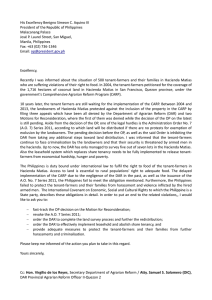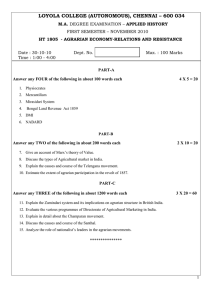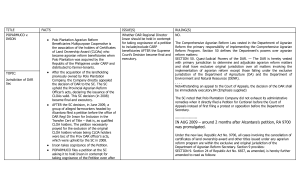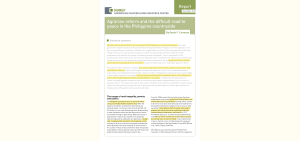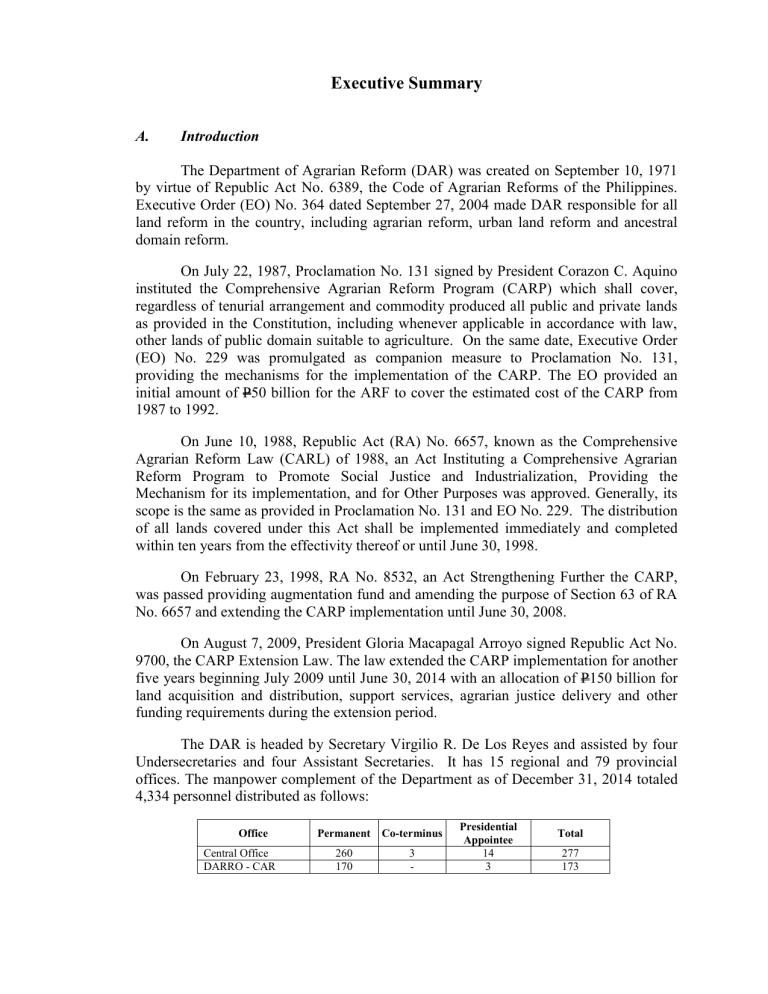
Executive Summary A. Introduction The Department of Agrarian Reform (DAR) was created on September 10, 1971 by virtue of Republic Act No. 6389, the Code of Agrarian Reforms of the Philippines. Executive Order (EO) No. 364 dated September 27, 2004 made DAR responsible for all land reform in the country, including agrarian reform, urban land reform and ancestral domain reform. On July 22, 1987, Proclamation No. 131 signed by President Corazon C. Aquino instituted the Comprehensive Agrarian Reform Program (CARP) which shall cover, regardless of tenurial arrangement and commodity produced all public and private lands as provided in the Constitution, including whenever applicable in accordance with law, other lands of public domain suitable to agriculture. On the same date, Executive Order (EO) No. 229 was promulgated as companion measure to Proclamation No. 131, providing the mechanisms for the implementation of the CARP. The EO provided an initial amount of P50 billion for the ARF to cover the estimated cost of the CARP from 1987 to 1992. On June 10, 1988, Republic Act (RA) No. 6657, known as the Comprehensive Agrarian Reform Law (CARL) of 1988, an Act Instituting a Comprehensive Agrarian Reform Program to Promote Social Justice and Industrialization, Providing the Mechanism for its implementation, and for Other Purposes was approved. Generally, its scope is the same as provided in Proclamation No. 131 and EO No. 229. The distribution of all lands covered under this Act shall be implemented immediately and completed within ten years from the effectivity thereof or until June 30, 1998. On February 23, 1998, RA No. 8532, an Act Strengthening Further the CARP, was passed providing augmentation fund and amending the purpose of Section 63 of RA No. 6657 and extending the CARP implementation until June 30, 2008. On August 7, 2009, President Gloria Macapagal Arroyo signed Republic Act No. 9700, the CARP Extension Law. The law extended the CARP implementation for another five years beginning July 2009 until June 30, 2014 with an allocation of P150 billion for land acquisition and distribution, support services, agrarian justice delivery and other funding requirements during the extension period. The DAR is headed by Secretary Virgilio R. De Los Reyes and assisted by four Undersecretaries and four Assistant Secretaries. It has 15 regional and 79 provincial offices. The manpower complement of the Department as of December 31, 2014 totaled 4,334 personnel distributed as follows: Office Central Office DARRO - CAR Permanent Co-terminus 260 170 3 - Presidential Appointee 14 3 Total 277 173 Office I II III IV-A IV-B V VI VII VIII IX X XI XII CARAGA Total B. Permanent Co-terminus 204 249 404 325 115 332 514 297 358 238 218 196 240 157 4,277 3 Presidential Appointee 3 3 3 3 1 2 3 1 3 2 3 2 4 4 54 Total 207 252 407 328 116 334 517 298 361 240 221 198 244 161 4,334 Financial Highlights The financial condition, performance and sources and application of funds of DAR as of December 31, 2014 are shown below: CY 2014 Financial Condition Assets Liabilities Net Assets/Equity Financial Performance Revenue Net Financial Assistance/Subsidy Gains Losses Total Current Operating Expenses Surplus/(Deficit) for the Period Sources and Application of Funds Allotments Total Obligations Unobligated Balance C. P 18,342,062,705.33 2,144,826,040.56 16,197,236,664.77 43,863,831.54 12,529,944,945.90 3,099,603.98 (2,945,223.91) 12,573,963,157.51 9,649,093,633.78 2,924,869,523.73 17,750,974,026.52 11,889,914,830.69 5,861,059,195.83 Scope and Objectives of the Audit The audit covered the accounts and operations of the DAR for the period January 1 to December 31, 2014. It was conducted to determine the (a) level of assurance that may be placed on management’s assertions on the financial statements; (b) propriety of transactions as well as the extent of compliance with applicable laws, ii rules and regulations; and (c) the extent of the implementation of prior years’ audit recommendations. Value for Money Audit was conducted on the status of the attainment of the targeted activities under the Foreign Assisted Projects namely: Agrarian Reform Infrastructure Support Project Phase III (ARISP III) and Mindanao Sustainable Settlement Area Development Project (MinSAAD). Also included were the implementation of the ARCCESS project under the Comprehensive Agrarian Reform Program and the Grassroots Participatory Budgeting Process as of year-end. The financial statements (FS) as of December 31, 2014 are the combined FS of the Office of the Secretary and all the regional (DARROs) and provincial (DARPOs) offices. Part II of this report, however, does not include the observations and recommendations pertaining to DARROs and DARPOs of CAR, IV-A, VII and XI since no reports were received as of cut-off date. D. Auditor’s Report A qualified opinion was rendered on the fairness of presentation of the financial statements due to the accounting errors and other deficiencies, which are summarized in Annex A and discussed in detail in Part II of the report. E. Other Significant Observations and Recommendations Among the significant observations, in addition to the accounting errors and deficiencies, which were discussed in detail in Part II, are summarized as follows: 1. The purpose of the acquisition of the Common Service Facilities (CSF) equipment by the DAR-OSEC for the identified agrarian reform organizations was not fully attained due to non-maximization of their usage, some delivered/procured equipment were not the ones needed as assessed in the study; and the beneficiaries were not given enough trainings on the operation of the modern farm machinery. (Observation No. 1) We recommended and management agreed to: (a) assess the immediate needs of the ARBOs to know if the use of the given machinery is maximized in their organization, if not, consider sharing the use with the ARBOs nearest their location; (b) procure/acquire only those equipment which are in accordance with the assessed needs to maximize their usage; and iii (c) 2. instruct regional/provincial offices to require the equipment suppliers to give/provide the beneficiaries sufficient trainings on the operation/ use/maintenance of the modern farm equipment. On its 3rd year of implementation, the MinSAAD project is already considerably delayed with only the procurement of equipment support, pre-implementation and administrative activities had been accomplished and corresponding total disbursements of P248.851 million out of the total loan and GOP fund of P4.403 billion, thus, resulted in commitment fees of P5.016 million and P2.935 million in CYs in 2014 and 2013, respectively. (Observation No. 2) We recommended that management require the: 3. (a) Program Management Office to formulate strategies to accelerate project implementation to catch-up on the project timelines; (b) officials and staff to base the claim of honorarium on the accomplishment of the activities as targeted; (c) Accountant to charge the expenses which are directly related to the project only; and (d) Budget Officer to properly allocate administrative costs in accordance with the activities conducted and to last until the end of the project life. The completion of the ARISP III projects in Regions I, II, III, VI, X and XIII amounting to P196.499million were delayed due to suspension/cancellation of the projects, location disputes and insufficient LGU counterparts. (Observation No. 3) We recommended that management require the concerned regional/provincial offices to regularly coordinate with implementing agencies and conduct regular monitoring of projects. 4. Income of undetermined amount from the use of DAR facilities, electricity and water by the business establishments within the DAR premises were not billed/collected accordingly, thus, the agency was not able to generate income that could have been used to maintain the said facilities. (Observation No. 6) We recommended that the Administrator of the DAR facilities to: (a) inform the management of the Kiosk and DARMPC as well as the stall occupants inside the premises to pay their rentals and other dues to the DAR Cashier based on the Order of Payment (OP) issued by the Accounting Office; (b) conduct an estimate of the monthly consumption of water and electricity of the Canteen and Kiosk based on past data and require them to pay the amount iv due to DAR of their share of water and electricity expenses from the start of their operation; 5. (c) for current consumption, require them to install sub-meters for water and electricity and bill them regularly, or require them to apply for their own water and electricity connections; and (d) require DAREA and DARMPC to remit to the DAR Cashier all previous rental collections from the Kiosk and the stall occupants. Loans Receivable - Others amounting to P24.585 million in the three DARPOs of Region III remained outstanding for more than 14 years, the possibility of collection is remote due to managements’ lack of diligence in instituting action for the collection of the accounts or other appropriate remedies to clear the amount in the books. (Observation No. 13) We recommended and management agreed to: 6. (a) create a task force that will conduct review and analysis of the accounts in order to establish the validity and correctness of the account balances; (b) prepare the documentary requirements that will establish the existence of the accounts; and (c) if warranted, request/apply for the write-off of the accounts following the guidelines under COA Circular No. 97-001 dated February 5, 1997. Irregular and unnecessary expenses amounting to P70.050 million and P18.809 million, respectively, were incurred due to non-compliance with rules and regulations. (Observation No, 16) We recommended and management agreed to require the: (a) Heads of Personnel, OIC-Administrative Office - FAPsO, Budget Divisions of the DAR-OSEC to (i) submit the computation on the payments made, otherwise, require the refund of the excess payment of Honoraria, as well as the personal expenses reimbursed; (ii) justify/give legal bases for the procurement of insurance for the vehicles with a private insurance company instead of the GSIS; and (iii) submit justification on the rendition of overtime services ahead of authority, the charging of overtime pays from regular fund instead of from savings and payment of overtime services instead of thru compensatory time-off as mandated; (b) concerned officers and employees to refund the amount received pertaining to transactions which were considered irregular; v (c) DARPO Cagayan and Albay to (i) incur expenses only that are essential in the exigency of service in an economical manner; (ii) stop the issuance of mobile phones to personnel lower than Division Chief rank; (iii) require the return of cell phones issued to employees with rank below Division Chiefs and ensure that returned units are in good working condition; and (iv) require the payment equivalent to the acquisition cost of the mobile phones, in case of loss or damage; (d) DARPO Quirino to refrain from incurring unnecessary expenses like renting/leasing vehicles and maximize the utilization of the agency-owned transportation/motor vehicle for official business; (e) DARPO Isabela to refrain from incurring vehicle repairs more than 30 percent of its book value if not charged to capital outlay; (f) DARPO Negros Occidental to refrain from conducting Mass Processing of Claim Folders and Survey Returns in hotels and other venues that would entail catering services; (g) DARRO X to adhere to the limit set forth in the yearly GAA in spending for CARP Anniversary and similar activities; and (h) DARPO Lanao del Norte to require the Budget Officer, Accountant and Project Officer/s to (i) account the obligated amount for non-existent training activity or other projects under the Land Tenure Services by submitting corresponding summary list of disbursements indicating the date, check number, amount and nature of transactions charged to the obligated amount. F. Status of Audit Suspensions and Disallowances Audit suspensions and disallowances totaling P121.384 million and P683.496 million, respectively, remained unsettled as of year-end. G. Implementation of Prior Years’ Recommendations Out of the 120 audit recommendations embodied in the CY 2013 Consolidated Annual Audit Report (CAAR), 10 or 8 percent were fully implemented, 32 or 27 percent were partially implemented and 78 or 65 percent were not implemented. vi
